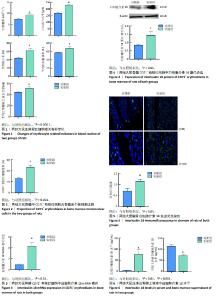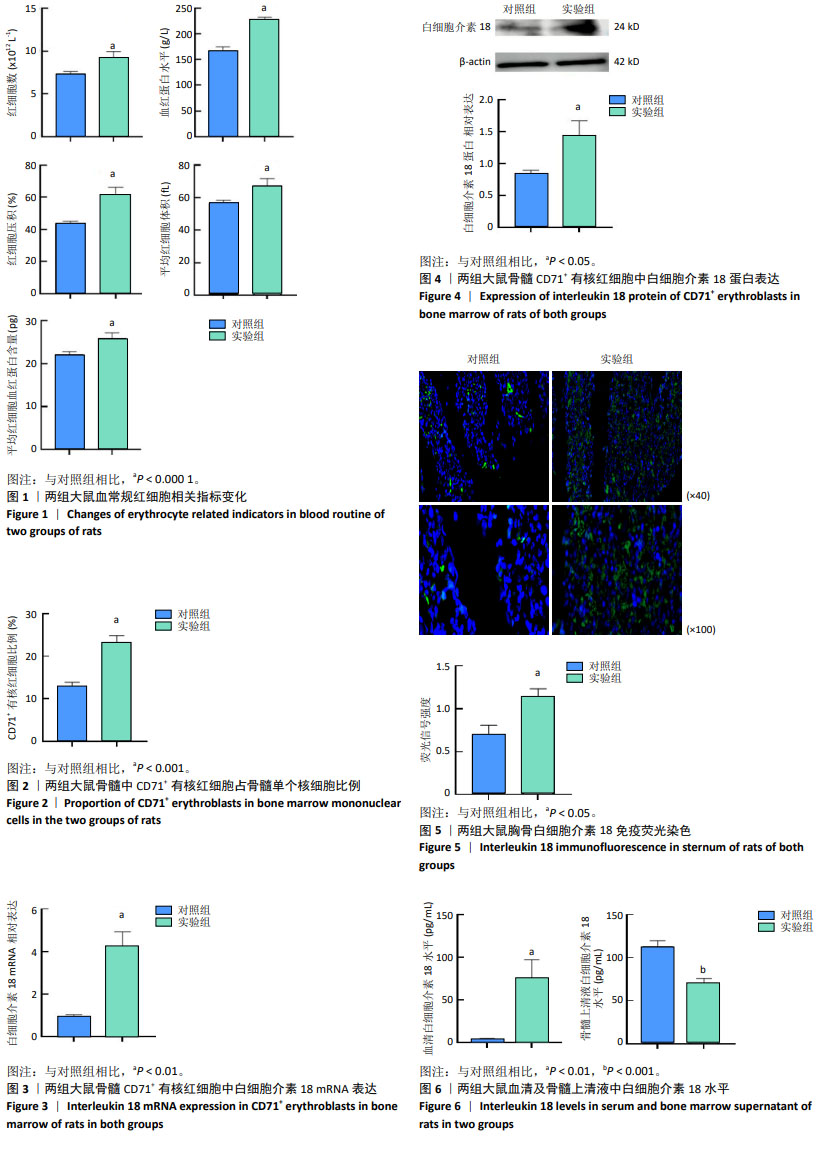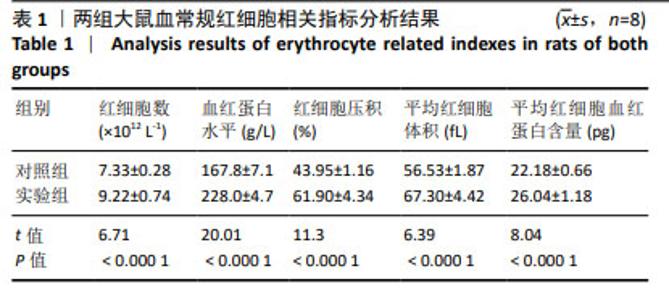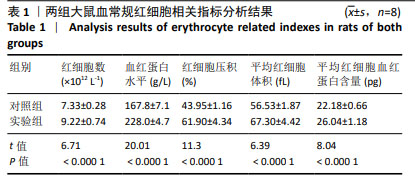Chinese Journal of Tissue Engineering Research ›› 2025, Vol. 29 ›› Issue (31): 6681-6687.doi: 10.12307/2025.557
Previous Articles Next Articles
Significance of interleukin-18 expression in bone marrow and peripheral blood of rats exposed to hypoxia
Li Jinjie, Xiao Jingxue, Li Nan, Song Zhen, Zhou Yanyun, Ma Jie#br#
- Li Jinjie, Xiao Jingxue, Li Nan, Song Zhen, Zhou Yanyun, Ma Jie
-
Received:2024-08-05Accepted:2024-10-08Online:2025-11-08Published:2025-02-24 -
Contact:Ma Jie, MD, Associate chief physician, Qinghai University Affiliated Hospital (Clinical Medicine School), Xining 810001, Qinghai Province, China -
About author:Li Jinjie, Master candidate, Qinghai University Affiliated Hospital (Clinical Medicine School), Xining 810001, Qinghai Province, China -
Supported by:Qinghai Province “Kunlun Talents•High-end Innovation and Entrepreneurship Talents” Program, No. 2020-18 (to MJ); Qinghai Provincial Science and Technology Department Natural Science Foundation Project, No. 2020-ZJ-956Q (to MJ)
CLC Number:
Cite this article
Li Jinjie, Xiao Jingxue, Li Nan, Song Zhen, Zhou Yanyun, Ma Jie. Significance of interleukin-18 expression in bone marrow and peripheral blood of rats exposed to hypoxia[J]. Chinese Journal of Tissue Engineering Research, 2025, 29(31): 6681-6687.
share this article
Add to citation manager EndNote|Reference Manager|ProCite|BibTeX|RefWorks

2.3 骨髓 CD71+有核红细胞比例 对照组、实验组骨髓CD71+有核红细胞占骨髓单个核细胞比例分别为 (12.91±2.10)%,(23.38±3.66)%,实验组明显高于对照组,两组间差异有显著性意义(t=5.86,P < 0.001),见图2,与血常规红细胞指标分析结果一致。 2.4 RT-qPCR检测骨髓CD71+有核红细胞中白细胞介素18 mRNA表达 实验组大鼠骨髓CD71+有核红细胞中白细胞介素18 mRNA表达较对照组明显升高,两组间差异有显著性意义(t=4.66,P < 0.05),见图3。 2.5 Western blot检测骨髓CD71+有核红细胞中白细胞介素18蛋白表达 实验组大鼠骨髓CD71+有核红细胞中白细胞介素18蛋白表达较对照组明显升高,两组间差异有显著性意义(t=2.64,P < 0.05),见图4。 2.6 免疫荧光测定胸骨组织中白细胞介素18表达 免疫荧光测定两组大鼠胸骨组织中均有白细胞介素18表达,实验组白细胞介素18表达较对照组明显增多,两组间差异有显著性意义(t= 3.27,P < 0.05),见图5。 2.7 ELISA测定血清及骨髓上清液中白细胞介素18水平 实验组血清中白细胞介素18水平显著高于对照组,两组间差异有显著性意义(t=3.36,P < 0.05),实验组骨髓上清液中白细胞介素18水平显著低于对照组,两组间差异有显著性意义(t=5.19,P < 0.05),见图6。 "

| [1] RICHALET JP, HERMAND E, LHUISSIER FJ. Cardiovascular physiology and pathophysiology at high altitude. Nat Rev Cardiol. 2024;21(2):75-88. [2] VILLAFUERTE FC, SIMONSON TS, BERMUDEZ D, et al. High-Altitude Erythrocytosis: Mechanisms of Adaptive and Maladaptive Responses. Physiology (Bethesda). 2022;37(4):175-186. [3] 熊权鑫.PI3K/AKT/NF-KB信号通路对高原红细胞增多症大鼠骨髓组织中HIF-1α表达变化的调控作用研究[D].成都:四川农业大学, 2018. [4] PAN Y, ZHANG Y, YUAN J, et al. Tetrahydrocurcumin mitigates acute hypobaric hypoxia-induced cerebral oedema and inflammation through the NF-κB/VEGF/MMP-9 pathway. Phytother Res. 2020;34(11): 2963-2977. [5] LIU H, TANG F, SU J, et al. EPAS1 regulates proliferation of erythroblasts in chronic mountain sickness. Blood Cells Mol Dis. 2020;84:102446. [6] 马婕,冀林华,李占全,等.高原鼠兔与大鼠低氧后外周血及骨髓红系细胞变化特点[J].中国组织工程研究,2020,24(1):112-117. [7] LIU HH, SU J, MA J, et al. The expression of VHL/HIF signaling pathway in the erythroid progenitor cells with chronic mountain sickness. Zhonghua Yi Xue Za Zhi. 2019;99(34):2670-2674. [8] ZHANG L, LI M, WANG Z, et al. Cardiovascular Risk After SARS-CoV-2 Infection Is Mediated by IL18/IL18R1/HIF-1 Signaling Pathway Axis. Front Immunol. 2022;12:780804. [9] IHIM SA, ABUBAKAR SD, ZIAN Z, et al. Interleukin-18 cytokine in immunity, inflammation, and autoimmunity: Biological role in induction, regulation, and treatment. Front Immunol. 2022;13:919973. [10] WANG B, WANG X. Effects of interleukin-18 and hypoxia-inducible factor-1α in serum and gingival tissues of rat model with periodontitis exposed to chronic intermittent hypoxia. Hua Xi Kou Qiang Yi Xue Za Zhi. 2015;33(4):383-387. [11] 廖霞,罗凤鸣.高原人群肺动脉高压与血红蛋白浓度的相关研究进展[J].中国呼吸与危重监护杂志,2022,21(3):225-228. [12] 郭勇,王生艳,易静静,等.红景天苷对高原红细胞增多症模型大鼠骨髓CD71+有核红细胞凋亡的影响[J].吉林大学学报(医学版), 2023,49(5):1174-1181. [13] 苏思骢.高原红细胞增多症病程中肠道微生物作用的探索研究[D].北京:军事科学院,2021. [14] GATTERER H, VILLAFUERTE FC, ULRICH S, et al. Altitude illnesses. Nat Rev Dis Primers. 2024;10(1):43. [15] LYU Q, BAI Y, CHENG J, et al. Intermittent short-duration reoxygenation protects against simulated high altitude-induced pulmonary hypertension in rats. FASEB J. 2021;35(2):e21212. [16] SCHIPPEL N, SHARMA S. Dynamics of human hematopoietic stem and progenitor cell differentiation to the erythroid lineage. Exp Hematol. 2023;123:1-17. [17] RYBNIKOVA E, LUKYANOVA L. Molecular Mechanisms of Adaptation to Hypoxia. Int J Mol Sci. 2023;24(5):4563. [18] HU J, LIU J, XUE F, et al. Isolation and functional characterization of human erythroblasts at distinct stages: implications for understanding of normal and disordered erythropoiesis in vivo. Blood. 2013;121(16):3246-3253. [19] BAPAT A, SCHIPPEL N, SHI X, et al. Hypoxia promotes erythroid differentiation through the development of progenitors and proerythroblasts. Exp Hematol. 2021;97:32-46.e35. [20] DIXON KO, KUCHROO VK. IL-18: throwing off the shackles to boost anti-tumor immunity. Cell Res. 2020;30(10):831-832. [21] BOURAS E, KARHUNEN V, GILL D, et al. Circulating inflammatory cytokines and risk of five cancers: a Mendelian randomization analysis. BMC Med. 2022;20(1):3. [22] IVASHKIV LB. The hypoxia-lactate axis tempers inflammation. Nat Rev Immunol. 2020;20(2):85-86. [23] 李英兰,娄明远,崔晓珊,等.海拔4300米高原红细胞增多症患者血清炎症因子及认知功能障碍的研究[R].青海省人民医院, 2019-11-20. [24] HUANG H, YANG L. Research Progress of Inflammatory Factors in Chronic Obstructive Pulmonary Disease with Pulmonary Hypertension at High Altitude. Altern Ther Health Med. 2023;29(8): 689-693. [25] LIU H, WANG Y, ZHANG Q, et al. Macrophage-derived inflammation promotes pulmonary vascular remodeling in hypoxia-induced pulmonary arterial hypertension mice. Immunol Lett. 2023;263: 113-122. [26] PALAZON A, GOLDRATH AW, NIZET V, et al. HIF transcription factors, inflammation, and immunity. Immunity. 2014;41(4):518-528. [27] CUMMINS EP, KEOGH CE, CREAN D, et al. The role of HIF in immunity and inflammation. Mol Aspects Med. 2016;47-48:24-34. [28] ZHAO B, NIU X, HUANG S, et al. TLR4 Agonist and Hypoxia Synergistically Promote the Formation of TLR4/NF-κB/HIF-1α Loop in Human Epithelial Ovarian Cancer. Anal Cell Pathol (Amst). 2022;2022:4201262. [29] ZHANG Z, HUANG Y, ZHANG J, et al. Activation of NF-κB signaling pathway during HCG-induced VEGF expression in luteal cells. Cell Biol Int. 2019;43(3):344-349. [30] KORBECKI J, SIMIŃSKA D, GĄSSOWSKA-DOBROWOLSKA M, et al. Chronic and Cycling Hypoxia: Drivers of Cancer Chronic Inflammation through HIF-1 and NF-κB Activation: A Review of the Molecular Mechanisms. Int J Mol Sci. 2021;22(19):10701. [31] SPIRIG R, DJAFARZADEH S, REGUEIRA T, et al. Effects of TLR agonists on the hypoxia-regulated transcription factor HIF-1alpha and dendritic cell maturation under normoxic conditions. PLoS One. 2010;5(6):e0010983. [32] COUTINHO-WOLINO KS, ALMEIDA PP, MAFRA D, et al. Bioactive compounds modulating Toll-like 4 receptor (TLR4)-mediated inflammation: pathways involved and future perspectives. Nutr Res. 2022;107:96-116. [33] KIANI AA, ELYASI H, GHOREYSHI S, et al. Study on hypoxia-inducible factor and its roles in immune system. Immunol Med. 2021;44(4): 223-236. [34] MCGETTRICK AF, O’NEILL LAJ. The Role of HIF in Immunity and Inflammation. Cell Metab. 2020;32(4):524-536. [35] CHEN Y, GABER T. Hypoxia/HIF Modulates Immune Responses. Biomedicines. 2021;9(3):260. [36] TAO Z, WANG J, WEN K, et al. Pyroptosis in Osteoblasts: A Novel Hypothesis Underlying the Pathogenesis of Osteoporosis. Front Endocrinol (Lausanne). 2021;11:548812. [37] ALLEGRA A, VINCELLI D, SPATARI G, et al. Evaluation of interleukin-18 levels in patients affected by multiple myeloma and monoclonal gammopathy of undetermined significance: analysis and review of the literature. Eur Rev Med Pharmacol Sci. 2024;28(12):3880-3887. [38] FIORDI B, SALVESTRINI V, GUGLIOTTA G, et al. IL-18 and VEGF-A trigger type 2 innate lymphoid cell accumulation and pro-tumoral function in chronic myeloid leukemia. Haematologica. 2023;108(9):2396-2409. [39] YASUDA K, NAKANISHI K, TSUTSUI H. Interleukin-18 in Health and Disease. Int J Mol Sci. 2019;20(3):649. [40] MIYAZAWA H, WADA T. Immune-mediated inflammatory diseases with chronic excess of serum interleukin-18. Front Immunol. 2022;13: 930141. |
| [1] | Yang Zhihang, Sun Zuyan, Huang Wenliang, Wan Yu, Chen Shida, Deng Jiang. Nerve growth factor promotes chondrogenic differentiation and inhibits hypertrophic differentiation of rabbit bone marrow mesenchymal stem cells [J]. Chinese Journal of Tissue Engineering Research, 2025, 29(7): 1336-1342. |
| [2] | Liu Qi, Li Linzhen, Li Yusheng, Jiao Hongzhuo, Yang Cheng, Zhang Juntao. Icariin-containing serum promotes chondrocyte proliferation and chondrogenic differentiation of stem cells in the co-culture system of three kinds of cells [J]. Chinese Journal of Tissue Engineering Research, 2025, 29(7): 1371-1379. |
| [3] | Zhang Mingyang, Yang Xinling. Verbascoside inhibits Erastin-induced ferroptosis of dopaminergic nerve cell line MN9D cells [J]. Chinese Journal of Tissue Engineering Research, 2025, 29(7): 1408-1413. |
| [4] | Zhang Zhenyu, Liang Qiujian, Yang Jun, Wei Xiangyu, Jiang Jie, Huang Linke, Tan Zhen. Target of neohesperidin in treatment of osteoporosis and its effect on osteogenic differentiation of bone marrow mesenchymal stem cells [J]. Chinese Journal of Tissue Engineering Research, 2025, 29(7): 1437-1447. |
| [5] | Sun Xianjuan, Wang Qiuhua, Zhang Jinyi, Yang Yangyang, Wang Wenshuang, Zhang Xiaoqing. Adhesion, proliferation, and vascular smooth muscle differentiation of bone marrow mesenchymal stem cells on different electrospinning membranes [J]. Chinese Journal of Tissue Engineering Research, 2025, 29(4): 661-669. |
| [6] | Zhuo Qiuyan, Jiang Qun, Xia Si, Lu Shiying, Liu Yandi, Dai Mei. Bone marrow hematopoiesis in rats with myelodysplastic syndrome: action mechanism of Huosui Formula in intervening immune checkpoints [J]. Chinese Journal of Tissue Engineering Research, 2025, 29(36): 7735-7742. |
| [7] | Ge Xiao, Zhao Zhuangzhuang, Guo Shuyu, Xu Rongyao. HOXA10 gene-modified bone marrow mesenchymal stem cells promote bone regeneration [J]. Chinese Journal of Tissue Engineering Research, 2025, 29(36): 7701-7708. |
| [8] | Zhang Xiongjinfu, Chen Yida, Cheng Xinyi, Liu Daihui, Shi Qin . Exosomes derived from bone marrow mesenchymal stem cells of young rats to reverse senescence in aged rat bone marrow mesenchymal stem cells [J]. Chinese Journal of Tissue Engineering Research, 2025, 29(36): 7709-7718. |
| [9] | Sima Xinli, Liu Danping, Qi Hui. Effect and mechanism of metformin-modified bone marrow mesenchymal stem cell exosomes on regulating chondrocytes [J]. Chinese Journal of Tissue Engineering Research, 2025, 29(36): 7728-7734. |
| [10] | Yu Hui, Yang Yang, Wei Ting, Li Wenli, Luo Wenqian, Liu Bin. Gadd45b alleviates white matter damage in chronic ischemic rats by modulating astrocyte phenotype [J]. Chinese Journal of Tissue Engineering Research, 2025, 29(36): 7797-7803. |
| [11] | Wang Qingfang, Zhang Fen, Chang Guangping, Li Zihan, Xing Lan, Peng Hao, Zeng Xiuping, Zhong Guiqiang, Chen Hui, Liu Bo, Liu Zhenyu, Liang Xiao. Effect of a novel cryoprotectant in tissues and cells [J]. Chinese Journal of Tissue Engineering Research, 2025, 29(36): 7816-7826. |
| [12] | Zhao Nan, Ding Yong, Xiu Hang, Liu Pengfei, Liang Guogang. Extraction and culture of enteric glial cells from C57BL/6 newborn neonatal mice [J]. Chinese Journal of Tissue Engineering Research, 2025, 29(31): 6656-6660. |
| [13] | Wang Zhaoyan, Wang Qian, Liu Weipeng, Yang Hui, Luan Zuo, Qu Suqing. Effect of fibronectin on differentiation of human neural stem cells into oligodendrocyte precursor cells [J]. Chinese Journal of Tissue Engineering Research, 2025, 29(31): 6661-6666. |
| [14] | Kang Linzhi, Liu Zhenshuai, Wei Jiaxu, Chang Na, Zhu Dacheng. Inhibitory effects of sinomenine hydrochloride in T-cell acute lymphoblastic leukemia CEM cells and transcriptomic analysis [J]. Chinese Journal of Tissue Engineering Research, 2025, 29(31): 6674-6680. |
| [15] | Su Qin, Jia Siwei, Guo Minfang, Meng Tao, Li Yanbing, Mu Bingtao, Song Lijuan, Ma Cungen, Yu Jiezhong. Lycium barbarum polysaccharide intervenes in SH-SY5Y cell injury induced by beta-amyloid protein 1-42: protective effect of mitochondrial autophagy [J]. Chinese Journal of Tissue Engineering Research, 2025, 29(31): 6688-6696. |
| Viewed | ||||||
|
Full text |
|
|||||
|
Abstract |
|
|||||

